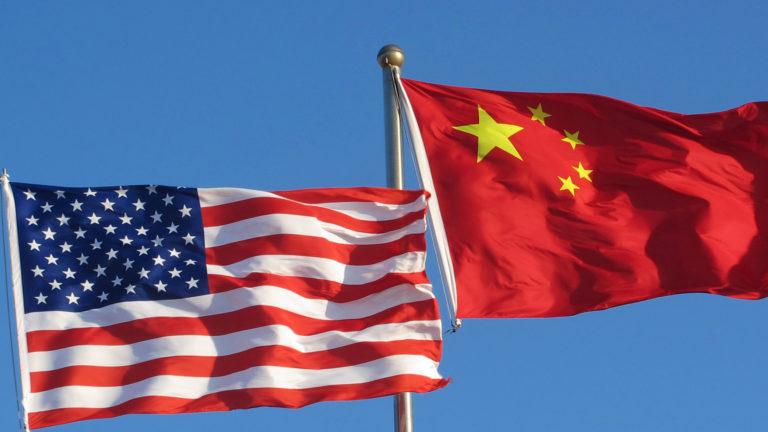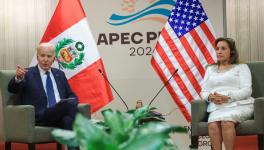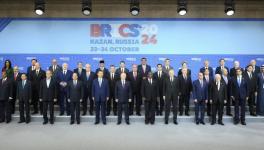Asymmetry in US-Russia-China Triangle

US-China dialogue in Anchorage, Alaska on March 16, 2021
The privilege of posing the first question to the Chinese State Councilor and Foreign Minister Wang Yi at the customary press conference last Sunday on the margins of the 13th National People’s Congress in Beijing went to the Tass correspondent. The extraordinary gesture, dripping with symbolism, was redolent of God offering Abraham a posterity like the stars of heaven.
The message was that with the international system facing disruption, China regards the relationship with Russia to be the main force of global strategic stability.
Wang said: “China and Russia standing together will remain a pillar of world peace and stability. The more unstable the world is, the greater the need for carrying forward China-Russia cooperation. China and Russia should be each other’s strategic support, development opportunity, and global partner. This is both an experience gained from history and an imperative under the current circumstances.”
He added, “We will set an example of strategic mutual trust, by firmly supporting each other in upholding core and major interests, jointly opposing “colour revolution” and countering disinformation, and safeguarding national sovereignty and political security.”
Of course, military alliance is not an option at the moment. As Yang Jin at the Institute of Russian, Eastern European and Central Asian Studies of the Chinese Academy of Social Sciences in Beijing (which comes under the State Council) put it recently, a formal alliance won’t be “flexible and will bring new problems”.
However, two days after Wang spoke, Tass reported on a Russia-China track 2 event where the top Moscow pundit Alexey Maslov, Director of the Institute of the Far East at the Russian Academy of Sciences, nonetheless proposed an alliance of sorts anyway. He cautioned the Chinese side that the Biden Administration will step up pressure on China “in several main areas” and is hell bent on preventing it from entering the high-tech sphere, especially with European partners, and implementing the “Made in China 2025” strategy.
Maslov noted that the US will continue with a containment strategy against China and Russia. “The US is trying to surround Russia and China with groups of conflicts. It is trying to impose a new global control system through conflict management. And so far, Russia and China are in the position of defending or justifying themselves. In my opinion, a joint Russian-Chinese concept is a very important step to stabilise the world right now.”
Maslov proposed that Moscow and Beijing should think of establishing a joint system of comprehensive security, which would cover other areas along with the military sphere, such as energy, banking, transmission of information. “Thus, Russia and China can offer a new concept of global stability through a new security concept,” Maslov concluded. (Tass)
The backdrop of this back-and-forth signalling is that the Biden administration’s first meeting with high-ranking Chinese officials is scheduled for next week. Washington and Beijing have announced (here and here) that US Secretary of State Antony Blinken and National Security Advisor Jake Sullivan will meet with Yang Jiechi, Politburo member and director of the Office of the Foreign Affairs Commission of the CPC Central Committee, and Wang Yi in a new “2+2” format on March 18-19 in Anchorage, Alaska for a high-level strategic dialogue.
Interestingly, by Thursday, when Maslov spoke for a second time on China he assumed a subdued tone. He told the Moscow daily Nezavisimaya Gazeta, “Despite the worsening political relationship, over the past two months Chinese exports to the US climbed 21%. So, the sides are boosting trade rather than decreasing it. So, exacerbating tensions while both economies require better relations would be simply unreasonable.”
Maslov noted that US president Joe Biden not only seeks to show that his China policy differs from Donald Trump’s but wants to demonstrate that he is ready for constructive dialogue with China if Beijing takes into account Washington’s demands. Maslov anticipates trade talks to resume to build upon the phase 1 agreement of December 2019.
But the salience of Maslov’s remarks lies in his candid estimation that China still has great interest in the US since it does not want to lose the American market but for the highly contentious issue is Chinese technologies, which the US is in no way willing to allow into Western markets. “It’s practically impossible to agree on this, and that’s why the issue of trade is becoming the most important one,” Maslov emphasised.
Maslov’s contradictory remarks hint at the growing angst in the Russian mind — Wang’s assuaging words notwithstanding. In fact, at a press conference in Beijing on Friday, replying to the CNN correspondent regarding the “2+2”, Premier Li Keqiang spoke positively about the talks at Anchorage. He said, inter alia,
“Some differences and disagreements are hardly avoidable, and some could be quite acute. But what matters most is how these differences and disagreements are handled. The Chinese and American peoples have the wisdom and capability. The two sides need to have dialogue and exchanges based on mutual respect and equality. We hope to see dialogue in multiple areas and at various levels. Even if we cannot work things out anytime soon, such exchange of views will help boost trust and dispel misgivings. It will also help us better manage and mitigate our differences.
“China and the United States have common interests. There are many areas where the two countries can cooperate. Last year, China-US trade bucked the trend and reached 4.1 trillion yuan, up by 8.8 percent over the previous year. The two countries need to put more energy on their common ground and expand converging interests. As permanent members of the UN Security Council, the two countries shoulder important responsibility for maintaining world peace and stability and promoting global prosperity and progress. We need to be future-oriented and overcome obstacles to move China-US relations in a direction of overall stability.”
Indeed, within 8 weeks of Biden’s inauguration, the US is entering into a strategic dialogue with China to reset relations. On the contrary, US-Russia relations are on a downhill path — more sanctions, more threatening deployments, more mutual recrimination. The bottom line is, Biden Administration shows no interest in engaging Moscow despite the latter’s manifest desire to get started. To be sure, an “asymmetry” is appearing in the US-Russia-China triangle as the Biden Administration’s policies toward Moscow and Beijing crystallise. Russia will watch closely what unfolds at the Anchorage talks.
Having said that, the “asymmetry” also extends to the US’ approach to China. Blinken shies away from calling this a “strategic dialogue” and is evasive that any follow-up will depend on how productive the forthcoming talks will be. The US is drawing from the Soviet-era toolkit — much foreplay is going on. One reason could be that the the US has to pacify its allies, especially the “Indo-Pacific” gang! So, there have been provocative US comments on China’s reform for Hong Kong’s electoral system, the sensitive issue of the Dalai Lama that is related to China’s Tibet, etc. Only last Wednesday, a US Navy guided-missile destroyer plowed through the Taiwan Straits, marking the third passage of an American naval vessel through the Straits since Biden took office.
Fundamentally, the Biden administration will not give up the adversarial mindset toward China (which reflects US domestic opinion too), and the relations will remain in a complex mode of competition-cum-cooperation –systemic rivalry. Unsurprisingly, Chinese analysts discourage any high expectations out of the forthcoming talks but also derive quiet satisfaction that the Biden Administration took the initiative to schedule the high level “strategic dialogue” as soon as possible — in itself a “positive development” signalling hope that through high-level talks, “the direction of the two countries’ relations can return to stable and constructive development track.”
The heart of the matter is that the proposed new “2+2” format is tailored to suit the needs for dialogue between the decision-making levels in Washington and Beijing, which could pave the way for a reset of China-US relationship — not only bring predictability and stability to it but also seek an early harvest.
With the pushback against the pandemic gaining traction and the massive 1.9 trillion economic relief package signed into law, Biden will be looking for gains on the foreign policy front that could provide underpinnings for his domestic agenda as well as help tackle global challenges. Beijing knows that and will be ready with proposals for a reset.
Get the latest reports & analysis with people's perspective on Protests, movements & deep analytical videos, discussions of the current affairs in your Telegram app. Subscribe to NewsClick's Telegram channel & get Real-Time updates on stories, as they get published on our website.





















